#offshore host
Explore tagged Tumblr posts
Text
#get a domain name uk#hosting website uk#web hosting monthly plans#deluxe web hosting#web hosting company uk#Hosting server UK#Web Hosting United Kingdom#web hosting offers#cpanel hosting uk#buy cpanel hosting#cloud server hosting providers#offshore hosting solutions#offshore hosting solutions uk#server hosting services#SoundCloud
0 notes
Text
Netherlands KVM VPS Hosting
Discover powerful Netherlands KVM VPS hosting solutions for robust performance. Get reliable, scalable services tailored for your needs.
0 notes
Text
In today's hyper-competitive digital landscape, your online presence needs to be as unique as your brand, and that's where Debut Infotech steps in.
As a part of this prominent custom Web development agency, we don't just build websites; we craft digital experiences. Our team is dedicated to finding creative solutions to your most complex challenges, enhancing user engagement, and maximizing your online potential by using cutting-edge technologies such as Angular, React, PHP, Laravel, Express JS, and many more. Contact us today to schedule a consultation and let's turn your web dreams into reality!
#tech#webdevelopment#webdesign#website#web developers#web hosting#tech news#techcrunch#technology#techwear#custom web development agency#web application development company#web application development services#offshore web development#offshore web development company#custom web app development services#custom web application development services#custom web development company#Custom Web Development Services#Web Development Services
1 note
·
View note
Text

The act of hosting a website on servers situated outside of one's own nation is known as offshore web hosting. This is typically done to obtain particular advantages.
0 notes
Note
hey gorgeous! how are you? can i request a story where carlos is just a normal guy with an average paying 9-5 and y/n is secretly a millionaire that’s a ceo with a massive company but hides it and lives in his small house and his average lifestyle but he somehow finds out and is complete shock? if not no problems ❤️
MY RICH GF | CS 55
carlos sainz x fem!reader
warn: no warn
hope you like it sender!! 🤍



There’s a saying—if you’ve ever read Fortune, the magazine that actually knows where the world’s richest hide their money:
"Not every millionaire is easy to pin down. Don’t trust any rich list you see—it barely scratches the surface." And that’s exactly how people describe The YLN Family.
Carlos had no clue. Not a single one.
Because as far as he knew, you were just a normal, stable employee at Finance Corporate—some mid-level corporate job that paid well enough but wasn’t flashy. You had a nice apartment, dressed well, never seemed to stress about money. But nothing about you screamed insane generational wealth. He never questioned it. Why would he? Not everyone in his life had to be ridiculously rich.
What he didn’t know was that your family owned the biggest car manufacturing empire in the world. That your father had spent millions making sure his family name was nowhere near any public records, that your assets were buried under layers of shell companies, trusts, and offshore accounts.
The only article that had ever mentioned your parents was some old feature in Legacy & Wealth, calling them “the ghost millionaires of the auto industry.” But that was it. No photos, no real details. Just speculation.
And Carlos? He was so far from putting the pieces together. He still thought youre just regular employee, but maybe you just saved up. He still thought it was a little weird that you never mentioned money struggles, but maybe you were just really good at managing finances.
The thought that you could buy and sell half the grid without breaking a sweat? Never even crossed his mind.
*****
Carlos had planned the night perfectly.
His company had been invited to the grand launch of your own company—some huge new venture that, apparently, was a big deal in the industry. He wasn’t exactly thrilled about going, but when he realized it was a black-tie event with free-flowing champagne, he figured he might as well make the most of it.
And since he didn’t want to go alone, he’d asked you to come with him.
"I can’t," you’d said over coffee that morning. "I have to work late."
He hadn’t pushed. You were always responsible like that—always staying late, never complaining. He even felt a little bad for you, missing out on a fancy event just to sit in an office under fluorescent lights.
Except now, standing in the middle of the ballroom, Carlos wasn’t sure whether to laugh or just be pissed.
Because there you were.
Not in an office. Not in work clothes. Not stuck behind a desk.
You were standing at the front of the room, shaking hands with executives, your name being announced like royalty. And as the words left the speaker’s lips—"Tonight, we celebrate the launch of (Company Name), a vision brought to life by none other than YFN"—Carlos finally realized.
You hadn’t been "working late."
You were hosting this.
Carlos downed the rest of his drink and walked up to you just as you stepped away from a conversation.
"You know," he said, voice laced with something sharp, "I didn’t realize 'working late' meant champagne and a whole damn ballroom."
You turned, eyes widening slightly in surprise before settling into something softer. "Carlos—"
"Guess I should’ve asked what kind of company you work for, huh?" His smile didn’t quite reach his eyes. "Would’ve been nice to know my girlfriend isn’t just 'doing fine' but actually—what do they call you? millionaire heir?"
There was a pause. You exhaled, pressing your lips together before tilting your head slightly.
"Are you mad?"
Carlos blinked.
He wanted to say yes. Wanted to tell you how stupid he felt for never realizing. But the truth was, he wasn’t angry. He was just—stunned.
"I don’t know," he admitted. "Should I be?"
You sighed, shifting closer. "I didn’t hide it to lie to you. I just… I wanted to be normal. With you."
Carlos let out a breath, running a hand through his hair. "And what, you thought I wouldn’t be able to handle it?"
You shook your head. "I thought you wouldn’t look at me the same."
Silence stretched between you. Then, finally, Carlos let out a dry chuckle, the tension in his shoulders easing just a little.
"You know, I should’ve guessed something was off when you never complained about rent."
You laughed, warm and genuine, and Carlos felt the last bit of his frustration melt away. Because at the end of the day, you were still you—the person he’d fallen for. The same way he was still him. And this? This was just another thing to understand about each other.
"So," he said, smirking slightly. "Since you’re secretly rich, does this mean you’re paying for dinner next time?"
You grinned, leaning in just enough for your perfume to cloud his thoughts.
"If you’re nice to me."
Carlos exhaled a laugh, shaking his head. "Unbelievable."
And just like that, everything was right again.
#f1 fanfiction#f1 fic#f1 imagine#carlos sainz fanfic#carlos sainz x reader#f1 fluff#carlos sainz#carlos sainz jr#cs55#f1 x reader
283 notes
·
View notes
Text
The Best News of Last Week - November 28, 2023
🐑 - Why did Fiona the sheep become a mountaineer? She was tired of the "baa-d" jokes at sea level!
1. Pope Francis dines with transgender women for Vatican luncheon

Pope Francis hosted a group of transgender women — many of whom are sex workers or migrants from Latin America — to a Vatican luncheon for the Catholic Church's "World Day of the Poor" last week.
The pontiff and the transgender women have formed a close relationship since the pope came to their aid during the COVID-19 pandemic, when they were unable to work. Now, they meet monthly for VIP visits with the pope and receive medicine, money and shampoo any day, according to The Associated Press.
2. New York just installed its first offshore wind turbine
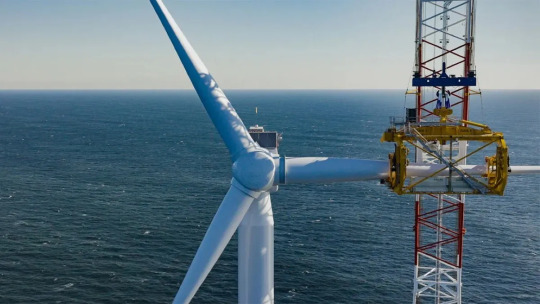
The first wind turbine installation at South Fork Wind, New York State’s first offshore wind farm, is complete.
The 130-megawatt (MW) South Fork Wind will be the US’s first completed utility-scale wind farm in federal waters.
3. Anonymous businessman donates $800k to struggling food bank
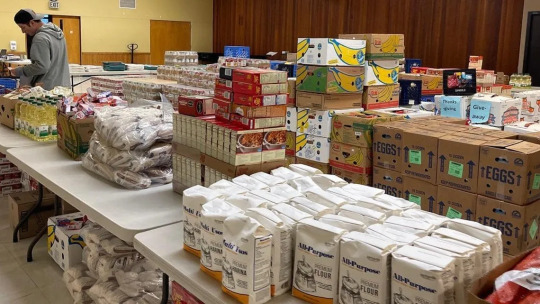
But this Thanksgiving, a longtime prayer of food bank leaders was finally answered: an anonymous benefactor donated the full $800,000 they needed to move out of a facility they've long outgrown. That benefactor, however, preferred to stay anonymous.
"Very private company, really don't want attention," said Debbie Christian, executive director of the Auburn Food Bank. "It's a goodhearted person that just wants to see the work here continue, wants to see it expand."
4. Empowering woman saving hopes and mental health of suffering Ukrainian kids

Kenza Hadij-Brahim is at the forefront of promoting Circle of Toys
Hadj-Brahim is helping to launch the Circle of Toys initiative. A project that provides Ukrainian children in need of some normality with preloved toys. This new initiative connects people with old toys they might otherwise throw away, with Ukrainian families in need who want to provide some comfort to their children in this distressing time.
Find Refuge said : “The endeavour is driven by a sincere purpose: spark joy, foster play, and bring a hint of normalcy back to the young lives in Ukraine.”
5. TWO LOST CITIES HIDDEN FOR CENTURIES WERE JUST DISCOVERED IN BOLIVIA

Researchers have found these areas not only housed structures and pyramids but it has been uncovered that there were advanced irrigation systems, earthworks, large towns, causeways, and canals that cover miles.
Dr. Heiko Prümers from the German Archaeological Institute, who was also involved in the study comments that “this indicated a relatively dense settlement in pre-Hispanic times. Our goal was to conduct basic research and trace the settlements and life there. The research sheds light on the sheer magnitude and magnificence of the civic-ceremonial centers found buried in the forest”.
6. Sheep dubbed Fiona rescued from cliff in Scotland where she was stuck for more than 2 years
youtube
And at last, some positive climate news:
7. Three positive climate developments
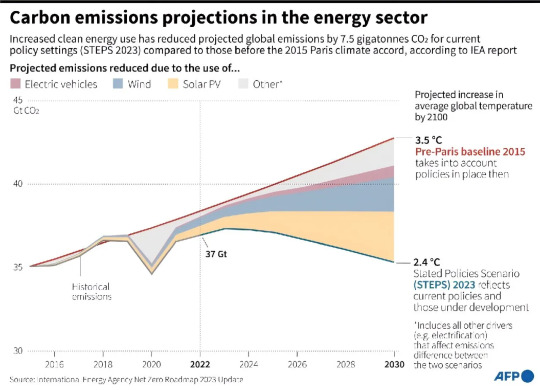
Heating
When the Paris Agreement was adopted, the global reliance on fossil fuels placed the world on a path towards a 3.5C rise in temperature by 2100. Eight years on, country commitments to reduce their carbon footprints have pulled that down slightly, putting the world on a path for a 2.5C to 2.9C by the end of the century.
Peak emissions
Annual greenhouse gas emissions responsible for climate change have risen roughly nine percent since COP21, according to UN data. But the rate of the increase has slowed significantly. Recent estimates by the Climate Analytics institute find global emissions could peak by 2024
Rising renewables
Three technologies—solar, wind and electric vehicles—are largely behind the improved global warming estimates since 2015.
---
That's it for this week :)
This newsletter will always be free. If you liked this post you can support me with a small kofi donation here:
Buy me a coffee ❤️
Also don’t forget to reblog this post with your friends.
816 notes
·
View notes
Text
The impossibly rich lifestyle of DC liberals, funded by YOU the taxpayer, without your consent or approval.
This is how they live, and the receipts prove it.
USAID, the NEA, and other taxpayer-funded programs issue billions of dollars in grants.
John and Jane, or Pete and Pete, each work at non-profits who receive these grants. The non-profit pays them $300,000 or more.
In some cases, such as the Kennedy Center, the CEO is paying $1.5 million.
A married couple takes in $750,000 together, and often much more.
Off of your back. Year after year, and the perks don't stop with salaries.
Believe it or not, that's small potatoes.
If they want a free ski vacation in Aspen?
Well there's a conference being held annually.
The non-profit will of course fly them there and provide accommodations. Every meal is of course non-profit related. Eat well.
Itching for a trip to Switzerland or Paris?
Same deal.
The non-profit would be delighted to host a conference on some subject.
How they cut their family and friends in on the scam.
Their nepo babies start a "conference organizing business," and pay them from the non-profit to put on events.
Maybe they take on an ownership interest in these businesses via an offshore account.
How will anyone be able to track down this money?
It's stash in the Cayman Islands or in Switzerland via one of the many "businesses" that provide "services" for the non-profit USAID industrial complex.
Speaker fees for their friends?
Yes, of course. That's how to really get the big bucks going, as speaking fees and vendors aren't accounted for item-by-item on the Form 990.
Hold a "gala" and pay everyone $100,000 to give a talk.
Pay millions to the "vendors" run by nepo babies and others in on the corruption.
Even judge / their families are in on these scams.
It's why DC judges are issuing lawless rulings.
Their spouses, friends, and families are all taking a piece of the action.
The end result of that DC exists entirely off of your back.
This corruption must end, and that's why they hate Elon.
They won't go down without a fight. These are all people living like billionaires for doing nothing.
Think this story is exaggerated. Look at these salaries from "non-profits," which are funded by taxpayers via grants and other "aid."
Now you understand the anger.
They are thieves!



144 notes
·
View notes
Text
2600’s amazing Hackers on Planet Earth con may go down under enshittification

Catch me in Miami! I'll be at Books and Books in Coral Gables on Jan 22 at 8PM.

It's been 40 years since Emmanuel Goldstein launched the seminal, essential, world-changing 2600: The Hacker Quarterly. 2600 wasn't the first phreak/hacker zine, but it was the most important, spawning a global subculture dedicated to the noble pursuit of technological self-determination:
https://www.2600.com/
2600 has published hundreds of issues in which digital spelunkers report eagerly on the things they've discovered by peering intently at the things no one was supposed to even glance at (I'm proud to be one of those writers!). They've fought legal battles, including one that almost went to the Supreme Court:
https://en.wikipedia.org/wiki/DeCSS
They created a global network of meetups where some of technology's most durable friendships and important collaborations were born. These continue to this day:
https://www.2600.com/meetings
And they've hosted a weekly radio show on NYC's WBAI, Off the Hook:
https://wbai.org/program.php?program=76
When WBAI management lost their minds and locked the station's most beloved hosts out of the studio, Off the Hook (naturally) led the rebellion, taking back the station for its audience, rescuing it from a managerial coup:
https://twitter.com/2600/status/1181423565389942786
But best of all, 2600 gave us HOPE – both in the metaphorical sense of "hope for a better technological tomorrow" and in the literal sense, with its biannual Hackers On Planet Earth con:
https://en.wikipedia.org/wiki/Hackers_on_Planet_Earth
For decades HOPE had an incredible venue, the Hotel Pennsylvania (memorialized in the phreak anthem "PEnnsylvania 6-5000"), a crumbling pile in midtown Manhattan that was biannually transformed into a rollicking, multi-day festival of forbidden technology, improbable feats, and incredible presentations. I was privileged to keynote HOPE in 2016:
https://www.youtube.com/watch?v=f1D7APjmVbk
But after the 2018 HOPE, the Hotel Pennsylvania was demolished to make way for the Penn15 (no, really) skyscraper, a vaporware mega-tower planned as a holding pen for luxury shopping and empty million-dollar condos sold to offshore war-criminals as safe-deposit boxes in the sky. The developer, Vornado (no, really) hasn't actually done all that – after demo'ing the Hotel Pennsylvania, they noped out, leave a large, unusable scar across midtown.
But HOPE wasn't lost. In 2022, the ever-resilient 2600 crew relocated to Queens, hosted by St John's University – a venue that was less glamorous that the Hotel Pennsylvania, but the event was still fantastic. Attendance fell from 2,000 to 1,000, but that was something they could work with, and reviews from attendees were stellar.
Good thing, too. 2600 is, first and foremost, a magazine publisher, and these have been hard years for magazines. First there was the mass die-off of indie bookstores and newsracks (I used to sell 2600 when I was a bookseller, and in the years after, I always took the presence of 2600 on a store's newsrack as an unimpeachable mark of quality).
Thankfully for 2600, their audience is (unsurprisingly) a tech-savvy one, so they were able to substitute digital subscriptions for physical ones:
https://www.2600.com/Magazine/DigitalEditions
Of course, many of those subscriptions came through Amazon's Kindle, because nerds were early Amazon adopters, and because the Kindle magazine publishing platform offered DRM-free distribution to subscribers along with a fair payout to publishers.
But then Amazon enshittified its magazine system. Having locked publishers to its platform, it rugged them and killed the monthly subscription fees that allowed publishers to plan for a steady output. Publishers were given a choice: leave Amazon (and all the readers locked inside its walled garden) or put your magazine into the Kindle Unlimited system:
https://www.amazon.com/kindle-dbs/arp/B0BWPTCP4K?deviceType=A1FG5NAKX0MRJL
Kindle Unlimited is an all-you-can-eat program for Kindle, which pays publishers and writers based on a system that is both opaque and easily gamed, with the lion's share of the money going to "publishers" who focus on figuring out how to cheat the algorithm. Revenues for 2600 – and all the other magazines that Amazon had sucked in and sucked dry – fell off a cliff.
Which brings me to the present moment. After 40 years, 2600 is still at it, having survived the bookstorepocalypse, the lunacy of public radio management, the literal demolition of their physical home by an evil real-estate developer, and Amazon's crooked accounting.
This is 2600, circa 2024, and 2024 a HOPE year:
https://www.hope.net/
Once again, HOPE has been scheduled for its new digs in Queens, July 12-14. Last week, HOPE sent out an email blast to their subscribers telling them the news. They expected to sell 500 tickets in the first 24 hours. They didn't even come close:
https://www.2600.com/content/hope-ticket-sales-update
It turns out that Google and the other major mail providers don't like emails with the word "hacker" in them. The cartel that decides which email gets delivered, and which messages go to spam, or get blocked altogether, mass-blocked the HOPE 2024 announcement. Email may be the last federated, open platform we have, but mass concentration has created a system where it's nearly impossible to get your email delivered unless you're willing to play by Gmail's rules:
https://pluralistic.net/2021/10/10/dead-letters/
For Emmanuel Goldstein, founder of 2600 and tireless toiler for this community, the deafening silence following from that initial email volley was terrifying: "like some kind of a "Twilight Zone" episode where everyone has disappeared."
The enshittification that keeps 2600's emails from being delivered to the people who asked to receive them is even worse on social media. Social media companies routinely defraud their users by letting them subscribe to feeds, then turning around to the people and organizations that run those feeds and saying, "You've got x thousand subscribers on this platform, but we won't put your posts in their feeds unless you pay us to 'boost' your content":
https://www.eff.org/deeplinks/2023/04/platforms-decay-lets-put-users-first
Enshittification has been coming at 2600 for decades. Like other forms of oddball media dedicated to challenging corporate power and government oppression, 2600 has always been a ten-years-ahead preview of the way the noose was gonna tighten on all of us. And now, they're on the ropes. HOPE can't sell tickets unless people know about HOPE, and neither email providers nor social media platforms have any interest in making that happen.
A handful of giant corporations now get to decide what we read, who we hear from, and whether and how we can get together in person to make friends, forge community, rabble-rouse and change the world. The idea that "it's not censorship unless the government does it" has always been wrong (not all censorship violates the First Amendment, and censorship can be real without being unconstitutional):
https://pluralistic.net/2022/12/04/yes-its-censorship/
What can you do about it? Well, for one thing, you can sign up for HOPE. It's gonna be great. They've got sub-$100 hotel rooms! In New York City!
https://store.2600.com/products/tickets-to-hope-xv
If you can't make it to HOPE, you can sign up for a virtual membership:
https://store.2600.com/products/tickets-to-hope-xv-virtual-attendee
You can submit a talk to HOPE:
https://www.hope.net/cfp.html
You can subscribe to 2600, in print or electronically (I signed up for the lifetime print subscription and it was a bargain – I devour every issue the day it arrives):
https://store.2600.com/collections/subscriptions-renewals
2600 is living a decade in the future of every other community you care about, weird hobby you enjoy, con you live for, and publication you read from cover to cover. If we can all pull together to save it, it'll be a beacon of hope (and HOPE).

I'm Kickstarting the audiobook for The Bezzle, the sequel to Red Team Blues, narrated by @wilwheaton! You can pre-order the audiobook and ebook, DRM free, as well as the hardcover, signed or unsigned. There's also bundles with Red Team Blues in ebook, audio or paperback.

If you'd like an essay-formatted version of this post to read or share, here's a link to it on pluralistic.net, my surveillance-free, ad-free, tracker-free blog:
https://pluralistic.net/2024/01/19/hope-less/#hack-the-planet
#pluralistic#2600#hackers#magazines#publishing#kindle unlimited publishing#kindle#enshittification#monopoly#end to end#competition#events#nyc#hope#hackers on planet earth#amazon
425 notes
·
View notes
Text
#cloud server hosting providers#cPanel Web Hosting#offshore hosting solutions uk#offshore hosting solutions#cpanel hosting uk
1 note
·
View note
Text
Anonymous Web Hosting
Protect your online privacy with our anonymous web hosting services. Keep your identity secure with our top-notch anonymous hosting solutions.
0 notes
Text
Hmm. Alarming trend in mass incarceration in Central America.
Also: Very disingenuous wordplay here.

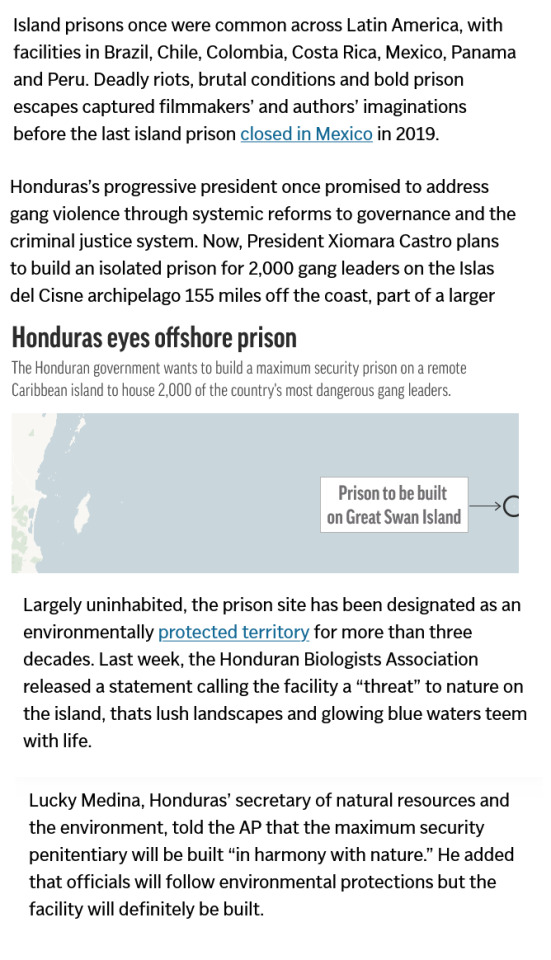
Where do we begin?
-- Very disingenuous for multiple outlets to run with "the West”. Though this initial AP article does specify that this refers to the Western Hemisphere, the choice to run headlines with “West” kinda implies that there are no other island prisons in “The West” (as in the European Union, the United States, Australia, etc.).
-- One of the most infamous incarceration schemes on the planet is Australia’s “Pacific Solution,” a “solution” to refugee migration centered on the imprisonment of asylum seekers on island prisons, including the infamous prisons at Nauru and Manus, both opened initially in 2001, and re-fortified after 2012. (Nauru is extremely isolated, in the South Pacific, 3000 kilometers away from the Australian coast; the Manus detention centre is far away off the northeast coast of Papua.) Since 2012, over 3,125 people have been sent to Nauru while over 4,180 people have been sent to Manus. (The “last refugee held on the Pacific island of Nauru under Australia’s offshore detention policy” was “evacuated” to mainland Australia only on 24 June 2023, not even a month prior to this headline.)
-- Obviously the EU incarcerates refugees on Mediterranean islands, notoriously at Moria on Lesbos, whose international reputation as the home of Sappho has been supplanted by its reputation as a de facto prison for asylum seekers. In October 2015, over 10,000 people landed on Lesbos in just one day. In 2017, the island averaged 2,500 arrivals per month. By 2019, humanitarian investigations showed that over 10,000 people were being held in a facility with a maximum capacity of 3,000. In 2020, fires left over 12,000 refugees on the island without shelter. By December 2021, Doctors Without Borders raised alarm that over 2,200 refugees were living in “dire” conditions on the island. As of early 2023, Lesbos (along with Kos, Leros, Chios, and Samos) is hosting over 4,500 people who are stuck in “reception and identification centers.”
-- And in the Western Hemisphere? The US prison at Guantanomo, also on the coast of an island in this same sea.
-- One of the most notorious island prisons was the early twentieth century French penal colony on the periphery of the Caribbean region at Guiana (run by a France, a “Western” power, in the Western Hemisphere), known internationally as “Devil’s Island.”
-- The federal government says the prison will be built “in harmony with nature.”
-- A prison ... in harmony with nature.
-- An island prison in the Caribbean, a region fundamentally and intimately connected to centuries of imprisonment, plantations, Indigenous genocide, antiBlackness, racial castes, and chattel slavery, all achieved and enforced through the bounded, isolated geographic containment structure allowed by islands.
-- And this is extra-worrying, because it seems it’s a regional trend, evidently for Honduras, El Salvador, and Colombia.
-- Merely a few days before this headline about Honduras, international outlets were profiling Honduras’s direct neighbor, El Salvador, with headlines like “Inside El Salvador’s new ‘mega prison’” (Al Jazeera) and, within the past couple months, headlines like “Prisoners are being tortured to death in El Salvador’s prisons” (VICE News).
-- From less than a week before this AP headline, we have BBC: “El Salvador’s secretive mega-jail.”


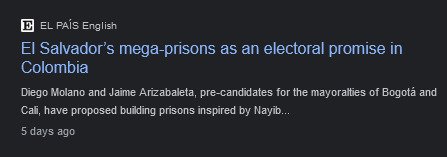
-- Don’t forget nearby Tapachula’s detention of asylum seekers.

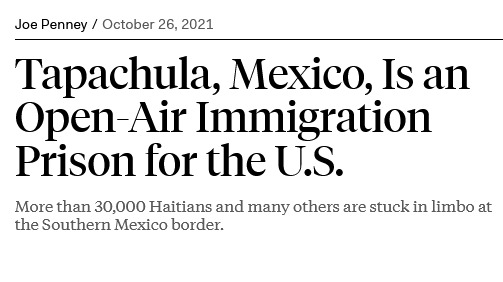
Still discussing implementation of literal island prisons despite our collective familiarity with carceral archipelagoes.


486 notes
·
View notes
Text

'The Early Rodentocene, 100 years post-establishment.
Before it was a paradise, it was a hamster hellscape.
Without predators to curb their numbers and a nigh-limitless supply of food, the first hamsters, having escaped the confines of Isla Genesis via land bridges that formed during a period of low sea levels, bred incessantly and exponentially. In the span of a century, they numbered in the hundreds of billions, becoming a tidal wave of hungry nibbling mouths that swept through Nodera, and then Easaterra, Westerna and Ecatoria like a rodent plague of continental proportions. They quickly ravaged the local plant life and introduced invertebrates, reducing once-lush grassland into barren wastes and driving many species of colonists to extinction as their numbers grew unchecked, their consumed biomass converted into even more hungry hamsters.
Eventually, having overrun the still-interconnected four main continents, they finally ran out of food, and began starving en masse: heaps upon heaps of tiny carcasses blanketing the landscape for miles on end and emanating the most terrible smell imaginable all across the land as they decomposed, a nauseating miasma of dead rodent times a hundred billion. And yet, in this putrid panorama of death and decay, some life endured. Fungi and microbes and flies and worms soon returned the nutrients of the dead to the soil, and dormant seeds and insect eggs awaiting the end of the scurrying storm burst back into bloom, nourished by the now richer earth. Trees, boasting lifespans measured in centuries, simply held off producing seeds and filled their leaves with distasteful tannins until the menacing swarms died down. Floating seeds and flying insects, blown across the sea from offshore islands and the unreachable Borealia, blew back inland and colonized the continents once again. And, with a new, enriched environment, new life flourishing once more, the world again became a paradise for the few hardy hamsters that survived the armageddon.
Unfortunately for them, it would eventually happen again, over and over, throughout the subsequent centuries. A pattern of extreme global boom-and-bust cycles of hamster populations defined the earliest days of the Early Rodentocene, as the ecosystem as a whole struggled to keep this rampant invading species under control. Time and time again, life would rebound from the devastation, only to be destroyed by the growing swarms once more within a few decades. As the centuries passed, however, the extreme pressure the hamsters put on the other species of the planet began to fuel their evolution: in a matter of just a few millennia, many plants, especially grasses, developed enormous rhizomes that grew deep underground, which continued to live on even as hamsters ate their leaves and stems. Invertebrates followed suit, laying large amounts of overwintering eggs in secluded places to assure at least some would survive, timing their emergence by evolutionary trial-and-error to times when hamsters were at their fewest. Some early plants became tougher, or more toxic, or thornier, while invertebrates retaliated with thicker exoskeletons, pinching mandibles, and painful stings to deter them from being eaten. Other species played an opposite game: instead satiating the predators with such a huge influx at the breeding season that they could not all be consumed, leaving a small percentage to survive and reproduce. Finally, and perhaps the most significant deterrent to the uncontrollable hordes, were the opportunistic microbes and invertebrates that, in the abundance of rodent hosts, became parasites and pathogens to them: ones that became particularly devastating when dense populations were in close contact, spreading quickly and causing large-scale deaths when numbers were too high.
As easily-accessible food became scarcer and starvation, disease, and competition began to take its toll, the population booms gradually became less and less severe as time went on, and the mass die-offs too became less and less devastating. Soon, new life began to flourish alongside the hamsters, not in spite of them, and, with their population levels now moderated by factors that kept them getting too overcrowded, the hamsters, once invaders, now became a part of the ecosystem. Some plants evolved to spread their seeds by having hamsters hoard them, while others relied on the nutrients spread by their droppings to grow. And by 10,000 years post-establishment, the periodic overpopulations and mass deaths were a thing of the past: balance restored to a biosphere disrupted by an unexpected arrival.
The world had changed to accommodate the newcomers: but the hamsters themselves were changed by this brutal cycle. With survivors sometimes as few as a hundred or so persisting each die-off, the gene pools narrowed and grew and fluctuated: and through rampant inbreeding, or genetic failsafes to combat the deleterious effects of lessened genetic variety, a plethora of mutations would gradually emerge in the once homogenous population: mutations that, with the aid of time and natural selection, became the catalyst that would shape the hamsters' future for the millions of years to come.'
---------
#speculative evolution#speculative biology#speculative zoology#spec evo#hamster's paradise#art one shot
73 notes
·
View notes
Text



An Offshore Wind Farm in England Hosts Hundreds of Potential Nests for Endangered Kittiwakes
326 notes
·
View notes
Text
"Merrimack Station, which is New England’s last running coal plant, will stop operating in 2028.
Granite Shore Power announced the closure of the Bow plant as part of a settlement agreement signed Wednesday, resolving litigation brought by the Conservation Law Foundation and the Sierra Club. Granite Shore Power will commit to shutting down coal-fired generators at the Schiller Station in Portsmouth by 2025. Currently, that plant has the capability to burn coal but hasn’t used its coal-fired generation since 2020.
Merrimack Station is a peaker plant, used to provide power on the region’s hottest or coldest days. In New England, coal makes up less than 1% of the region’s energy.
Granite Shore Power says the two plants will become “renewable energy parks.” Schiller Station is set to host a battery storage system that can provide power to the grid when there’s a lot of demand, and could serve as storage for offshore wind power.
Merrimack Station is expected to host about 100 megawatts of solar, along with more battery storage."
74 notes
·
View notes
Text
In an interview with Salem Radio talk show host Hugh Hewitt Monday, President-elect Donald Trump called President Joe Biden’s last-minute move to implement a drilling ban across vast swaths of federal waters “the worst abuse of power I’ve ever seen.
A Drilling Ban Bigger Than The Louisiana Purchase
The Biden White House announced earlier Monday the decision to set an area bigger than both the Louisiana Purchase and the states of Texas and Alaska combined - 625 million acres - off-limits from mineral development into perpetuity under the provisions of a 72 year-old law, a move that some believe is risky and could damage future U.S. energy security. The areas subject to the ban include most of the Atlantic seaboard, the Pacific coast from California to Washington, the eastern Gulf of Mexico, and parts of the Bering Sea off the north coast of Alaska.
12 notes
·
View notes
Text

Excerpt from this story from Yale Environment 360:
The November 5 election was the worst-case outcome for climate regulation. The return of Donald Trump to the Oval Office and Republican control of the Senate and the House of Representatives will halt federal progress and lead to a reversal of most of the climate initiatives undertaken by the Biden administration.
Such a rollback occurred after Trump first won election in 2016, but this time the stakes are even higher. Trump has promised to halt spending under the 2022 Inflation Reduction Act, the landmark climate law that dramatically increased federal support for clean energy technology and electric vehicles. And the president-elect has pledged to withdraw the United States from the Paris climate accord, reverse a key regulation aimed at reducing emissions from power plants, and roll back a host of key rules aimed at curbing climate change and air and water pollution.
Signs of light remain, however. Rapid advances in the technology and economics of clean energy have created a momentum that can be slowed but not stopped, with the cost of solar dropping globally by more than half since 2016. States and cities still retain much ability to reduce emissions and to prepare for the worsening physical impacts of climate change. But major progress will be in jeopardy because of the administration’s actions on a host of fronts.
Renewable Energy
A clean energy economy requires the construction of a massive number of new wind and solar farms and the associated electricity storage and transmission infrastructure. Such facilities are needed to replace all the old coal plants and most of the natural gas plants, and to provide the added power needed for electrifying vehicles, building heating systems, powering energy-intensive industries, meeting the demand for data centers for artificial intelligence and cryptocurrency, and other new loads. In 2022 Congress passed the Inflation Reduction Act (IRA), which is providing hundreds of millions of dollars in subsidies and tax breaks for clean energy. The IRA, coupled with rapidly dropping costs, has spurred a large upsurge in new projects.
The IRA passed Congress without a single Republican vote, and Trump has said he will ask Congress to repeal it. However, most of the IRA money for clean energy is going to districts represented by Republican members of Congress, many of whom oppose full repeal. Thus, Trump’s ability to eliminate the relevant parts of the IRA is in question, though a cap on the multiplicity of tax credits seems likely. However, the Internal Revenue Service under Trump could make it difficult to utilize the tax credits by issuing very restrictive interpretations of the credits or refusing to release the necessary forms.
The fate of the IRA will be an issue next year with the scheduled expiration of parts of the 2017 Trump tax cuts bill. Trump will presumably want to extend those tax cuts. Congress will be looking for ways to pay for this. Slashing IRA subsidies could be part of that.
Another expected Trump target is the fee imposed by the IRA on methane leakage from oil and gas production. Methane is a powerful greenhouse gas, and this fee is the first nationwide carbon tax in the U.S. The industry is pressing for its repeal, and Trump will clearly be sympathetic.
Wind and solar projects located on federal land or waters (which includes all offshore wind) require federal approval. Trump has often expressed antagonism to wind, and federal approvals for new wind projects are likely to stall. Wind and solar projects on private or state-owned land generally do not require federal approvals.
Motor Vehicles
A critical area where the new Trump administration is expected to slash environmental rules is motor vehicles, which are the largest source of greenhouse gas emissions in the U.S. Federal agencies set emission and fuel economy standards for motor vehicles. Under both Presidents Obama and Biden (with a halt by President Trump in between) both these standards were strengthened, leading to progressively cleaner cars. Regulations adopted late in the Biden administration are even stronger.
Federal law allows California to set its own even more stringent standards if EPA grants a waiver, and if it does, other states may adopt those. States that have traditionally followed the California standards amount to around 40 percent of the market for passenger cars. California has adopted rules that would phase out internal combustion engine cars and require that all new cars starting with the 2035 model year be zero-emission, and EPA has granted the needed waiver. Eight states have adopted plans requiring all new cars to be zero-emission by 2035, but this depends on the California waiver; without it, state laws inconsistent with the federal standards are preempted.
Both the stronger fuel economy standards and the California waiver are being challenged in court. Trump is likely to direct the EPA and the National Highway Traffic Safety Administration to freeze or weaken the standards and to revoke the California waiver, as he did during his first term. These actions, too, will face court challenges.
The automakers are, of course, free to make as many electric cars as they want and are already retooling to increase their output. But whether they are compelled to do so depends on the outcome of these court cases. And importantly, the subsidies for electric vehicles in the Inflation Reduction Act are also at risk, as Trump has said he would consider ending them.
Coal-Fired Power Plants
No one is building new coal-fired power plants in the U.S. any more, but there are about 225 still operating, and they are now the second largest source of greenhouse gases and also major emitters of unhealthy air pollutants such as fine particulates. Democratic administrations have for decades tried to accelerate their cleanup and closure, but the courts have frequently thrown up roadblocks. In 2024 the EPA issued a new rule that requires the eventual closure of these plants unless they install carbon capture and sequestration, a very expensive proposition. This too is being challenged in court and is very likely to be repealed by Trump.
Fossil Fuels
Trump has adopted the “drill baby drill” mantra. He has also promised to cut energy prices in half, mostly by greatly increasing production of oil and natural gas. However, current production levels under President Biden are the highest ever seen in the U.S., and higher than any other country in the world. This is mostly due to fracking, which has become the largest source of primary energy in the U.S. (47 percent in 2023). However, fracking is economical only if the prices of oil and natural gas are high enough; a drastic decline in prices will drive down production. Trump will probably open more federal lands and waters to oil and gas drilling, including in the Arctic National Wildlife Refuge, and relax environmental restrictions on them. But whether this will dramatically increase production is open to question.
Last January, Biden announced a temporary pause in the approval of new liquified natural gas export terminals. Trump will end that pause and try to expedite the approvals of these terminals and the associated pipelines.
International Agreements
Under Obama, the U.S. joined the Paris climate agreement; Trump withdrew; Biden rejoined; and Trump will no doubt pull out again. He might also go further and remove the U.S. from the United Nations Framework Convention on Climate Change, which the Senate ratified in 1992 and is the foundation for the Paris Agreement. Any of this would deny the U.S. a seat at the global climate bargaining tables and cede climate leadership to China.
For more than 30 years at the annual U.N. climate conference, the developing countries have been demanding “loss and damage” — compensation for the injuries they have suffered as a result of climate change. The U.S. has long been a target of these demands. With Trump in the White House and a Republican Congress, any hope of the U.S. providing funds for this purpose appears gone.
State and Local Action
While states cannot impose their own standards on motor vehicles without federal approval, in most other respects states are free to set stronger environmental standards than Washington. States can also adopt energy efficiency standards for appliances that are not subject to federal standards.
States and cities can use their procurement power to require low-emissions production of the cement, steel, and other commodities they buy and can demand clean motor vehicles and appliances. They purchase all of these in large quantities, which impacts manufacturers.
Blue states and cities, together with environmental groups, can be expected to vigorously litigate against Trump’s actions on climate change, as they did during Trump’s first term. The next four years will be rocky, indeed, and will keep lawyers on both sides very busy.
14 notes
·
View notes